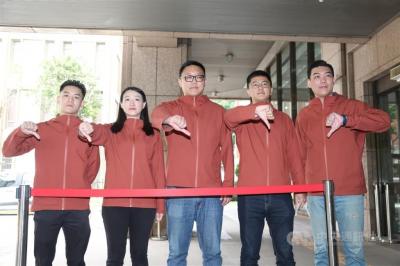A US academic’s recent call for greater transparency in reporting China’s military incursions into Taiwan’s air defense identification zone (ADIZ) presents a difficult choice, Minister of National Defense Wellington Koo (顧立雄) said yesterday.
“This is a dilemma for us,” Koo told reporters on the sidelines of a legislative meeting in Taipei in response to the criticism.
The Ministry of National Defense (MND) wants to make information more transparent, but there are also risks to doing that, Koo said.

Photo: Liao Cheng-hui, Taipei Times
If the MND disclosed too much information based on the results of its surveillance of Chinese People’s Liberation Army (PLA) forces, it could expose Taiwan’s intelligence and reconnaissance capabilities, and the potential sources of its information-gathering process, Koo said.
However, Koo pledged that the military would continue to regularly review the information it releases on PLA incursions to make it more transparent, while at the same time not disclosing its sources of intelligence during the process to protect national security.
Koo was responding to questions about criticisms of Taiwan’s military expressed by Thomas Shattuck, a special project manager at the University of Pennsylvania’s Perry World House policy research center, in a recent interview with the Central News Agency (CNA).
The MND has made frequent, unexplained changes in its public reporting of Chinese military activity in recent years, undermining the campaign’s effectiveness, Stattuck said.
There have also been inconsistencies between the Chinese and English-language versions of the reports, and changes — such as starting, and then halting, reporting of Chinese balloons — have been made without explanation or any clear logic, he said.
Shattuck said that the MND has a difficult task, but added that by sharing less and abruptly changing what it divulges, Taiwan risked making it seem as if the threat was “not as significant,” causing people in Taiwan and the US to care less, he said.
The MND has released a daily “real-time military update” documenting PLA incursions into Taiwan’s ADIZ since September 2020 to inform people at home and abroad of the increasing Chinese military threat.
An ADIZ is a self-declared area where a country claims the right to identify, locate and control approaching foreign aircraft, but is not part of its territorial airspace as defined by international law.
Separately, if the national defense budget for the domestic Hai Kun (海鯤) submarine construction project is cut next year, the earliest that funding for the program could be allocated is 2026, with implementation delayed until 2027, Koo said.
The Legislative Yuan’s Foreign and National Defense Committee is to continue reviewing next year’s national defense budget today, including the submarine construction project under the Indigenous Defense Submarine Program.
This program has a total proposed cost exceeding NT$284 billion (US$8.74 billion), with NT$1.9 billion to be allocated next year.
However, Chinese Nationalist Party (KMT) legislators Ma Wen-chun (馬文君), Huang Jen (黃仁) and Hsu Chiao-hsin (徐巧芯) have proposed cutting the submarine budget.
The MND has been communicating with the legislators and has assured them that the budget would not be used until the prototype submarine passes its sea trials, Koo said.
If the budget does not pass, not only would the timeline be delayed, but subcontractors would question Taiwan’s commitment to constructing the submarine, Koo said.
Additional reporting Wu Che-yu and Sam Garcia

Taiwan is stepping up plans to create self-sufficient supply chains for combat drones and increase foreign orders from the US to counter China’s numerical superiority, a defense official said on Saturday. Commenting on condition of anonymity, the official said the nation’s armed forces are in agreement with US Admiral Samuel Paparo’s assessment that Taiwan’s military must be prepared to turn the nation’s waters into a “hellscape” for the Chinese People’s Liberation Army (PLA). Paparo, the commander of the US Indo-Pacific Command, reiterated the concept during a Congressional hearing in Washington on Wednesday. He first coined the term in a security conference last

Prosecutors today declined to say who was questioned regarding alleged forgery on petitions to recall Democratic Progressive Party (DPP) legislators, after Chinese-language media earlier reported that members of the Chinese Nationalist Party (KMT) Youth League were brought in for questioning. The Ministry of Justice Investigation Bureau confirmed that two people had been questioned, but did not disclose any further information about the ongoing investigation. KMT Youth League members Lee Hsiao-liang (李孝亮) and Liu Szu-yin (劉思吟) — who are leading the effort to recall DPP caucus chief executive Rosalia Wu (吳思瑤) and Legislator Wu Pei-yi (吳沛憶) — both posted on Facebook saying: “I

Sung Chien-liang (宋建樑), who led efforts to recall Democratic Progressive Party (DPP) Legislator Lee Kun-cheng (李坤城), was released on bail of NT$80,000 today amid outcry over his decision to wear a Nazi armband to questioning the night before. Sung arrived at the New Taipei District Prosecutors’ Office for questioning in a recall petition forgery case last night wearing a red armband bearing a swastika, carrying a copy of Adolf Hitler’s Mein Kampf and giving a Nazi salute. Sung left the building at 1:15am without the armband and covering the book with his coat. Lee said today that this is a serious

A court has approved Kaohsiung prosecutors’ request that two people working for Democratic Progressive Party (DPP) Legislator Lin Dai-hua (林岱樺) be detained, as a probe into two cases allegedly involving her continues. The request was made on Friday, after prosecutors raided Lin’s two offices and the staffers’ residences, and questioned five on suspicion of contravening the Anti-Corruption Act (貪汙治罪條例). The people included the directors of Lin’s Daliao (大寮) and Linyuan (林園) district offices in Kaohsiung, surnamed Chou (周) and Lin (林) respectively, as well as three other staffers. The prosecutors’ move came after they interrogated Lin Dai-hua on Wednesday. She appeared solemn following